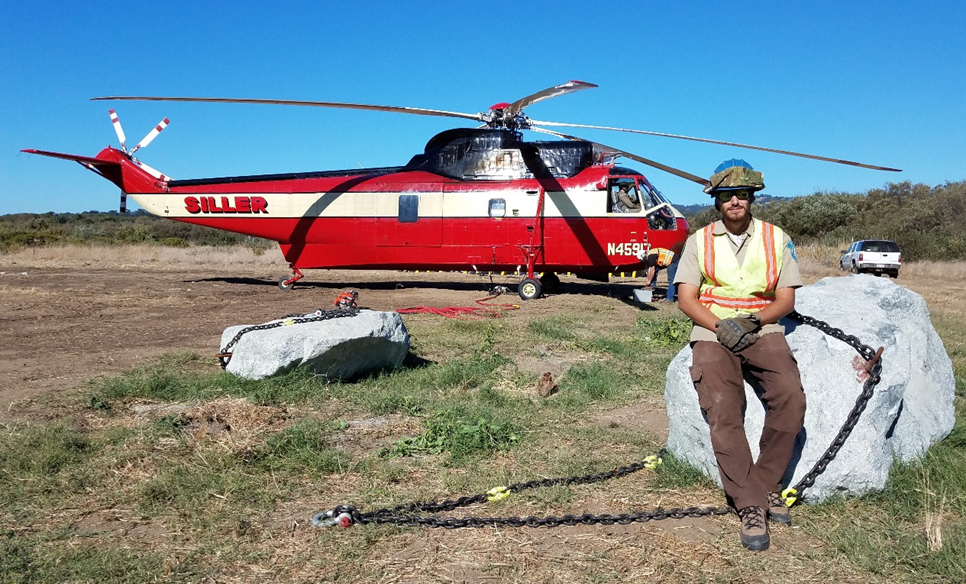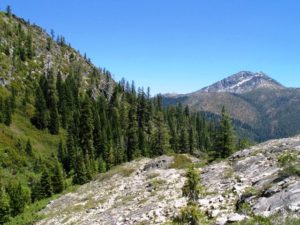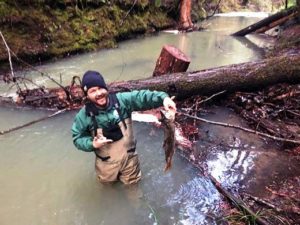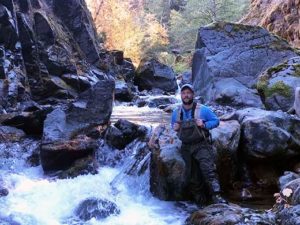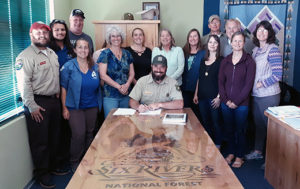On June 17, 2019, the Gasquet Ranger District/Smith River National Recreation Area—in collaboration with the Smith River Collaborative (SRC)—completed the environmental analysis for the Knopki South Project, which is focused on ecological restoration and fire-resilience.
Six Rivers National Forest Supervisor Ted McArthur signed the Decision Memo on June 12. “The collaborative approach we’re taking on the Six Rivers is not only good for the health of the forest— it’s good for our communities,” said McArthur.
“Knopki South is not only about ecological restoration; it’s about making our forest more resilient to high-severity wildfire, keeping our communities safe from wildfire, and contributing to our local economies,” he added.
The SRC is a joint venture between local Native American tribes (Elk Valley Rancheria and Tolowa Dee-ni′ Nation), Del Norte County elected officials, local and regional environmental groups (Friends of Del Norte, Klamath Forest Alliance, EPIC, KS Wild, and Smith River Alliance), Del Norte Fire Safe Council, and American Forest Resource Council, working in partnership with Six Rivers National Forest leadership.
The 875-acre integrated vegetation and fuels management Knopki South Project will restore habitats by promoting stand development in plantations, reduce hazardous fuel buildup along roads creating strategic fuelbreaks, reduce the potential for extreme wildfire conditions in the area, restore white oak stands and promote culturally important beargrass.
The project will also provide employment opportunities, commercial timber, fuelwood products and public firewood cutting areas that contribute to the local economy.
Another aspect of the environmental restoration work in this area has to do with helping military veterans.
For the past six years, National Oceanic and Atmospheric Administration (NOAA) Fisheries Division—in partnership with the California Conservation Corps (CCC)—have provided post-9/11 military veterans an opportunity to build their skills and work experience in fisheries research, monitoring and watershed restoration on the Six Rivers National Forest.
The latest Veterans Corps member on the forest is Ryan Shorrow. Prior to arriving on the Six Rivers in October 2018, Ryan was a fisheries technician at the CCC work center in Ukiah, California.
In thinking about the NOAA Fisheries / CCC partnership, Ryan said, “After serving in the Army, I struggled to find purpose after getting back to the real world and I really didn’t know what I wanted to do. When I found about the Veterans Corps Fisheries Program, I found that purpose. Before, I was ready to defend our country with a rifle, but now I’m serving in another capacity—helping protect, enhance and restore the Six Rivers National Forest and I love it!”
According to LeRoy Cyr, fish biologist for the Orleans, Ukonom and Lower Trinity Ranger District, “I am very proud to be involved in this cooperative partnership, and honored to be given the opportunity to mentor six military veterans, including Ryan.”
“Each of these individuals has excelled in improving and enhancing the Six Rivers’ fisheries and watershed restoration programs, while receiving training and on-the-ground experience. This is a great opportunity that will help these corps members compete and advance in natural resource fields,” he added.
The South Knopki Project is the outcome of a community-developed approach to treating hazardous fuels, and restoring terrestrial and aquatic habitats. This planning process was based on creating trust and building lasting relationships between community members, agencies, and organizations to accelerate protection and restoration of landscapes within Del Norte County.
The SRC is dedicated to developing projects that focus on thinning plantations (i.e., previously harvested stands) to promote habitat restoration, as well as treating hazardous fuels to help protect private property and federal land in the event of a wildfire.
Yet another aspect of local regeneration efforts is aquatic ecosystem restoration. On June 19, two days after signing-off on the Knopki South Project, Ted McArthur signed a Decision Notice to implement the Six Rivers Aquatic Restoration Project, designed to aid in the recovery of North Coast salmon and steelhead, and improve habitat for other aquatic and riparian species.
Designed to restore aquatic ecosystems through partnerships and collaboration, the Aquatic Restoration Project will use a variety of methods to enhance 1,234 stream miles of fisheries spawning, rearing, and over-wintering habitats associated with the Smith, Klamath, Trinity, Salmon, Mad, North Fork Eel and Van Duzen rivers and their tributaries; and improve habitat complexity along streams, and 1,156 acres of ponds and lakes.
According to Carolyn Cook, natural resources staff officer for the Six Rivers, “Getting the project to this point has been years in the making. It was finally brought to fruition by a shared vision between forest leadership and our collaborative partners and stakeholders who are dedicated to restoring fisheries on the North Coast.”
This project is also an important step toward fulfilling tribal trust responsibilities, and obligations to local communities, recreational users and commercial fishing industries.
Funding for the just-completed environmental analysis, including fish, wildlife, botany and archeology surveys, was provided through a grant from the California Coastal Conservancy through the Mid Klamath Watershed Council (MKWC). Numerous partners were involved in project development, including local tribes and non-governmental organizations, such as the Smith River Alliance and Humboldt State University; as well as other agencies, such as the National Marine Fisheries Service, US Fish and Wildlife Service, and California Department of Fish and Wildlife.
MKWC Director Luna Latimer concluded, “We are in a unique position—with tribal governments, non-governmental partners, and the Coastal Conservancy as a state-funding partner—to increase the pace, scale, and quality of restoration in key aquatic systems.” Adding, “A bonus of restoring aquatic habitat is its secondary effect—improving subsistence, commercial and recreational fishing, as well as providing immediate jobs for our rural communities.”
All photos are courtesy of U.S. Forest Service, except the featured photo (showing Fish Migration Vet Corps participant Ryan Sharrow in front of a helicopter) which is courtesy of NOAA Fisheries.

